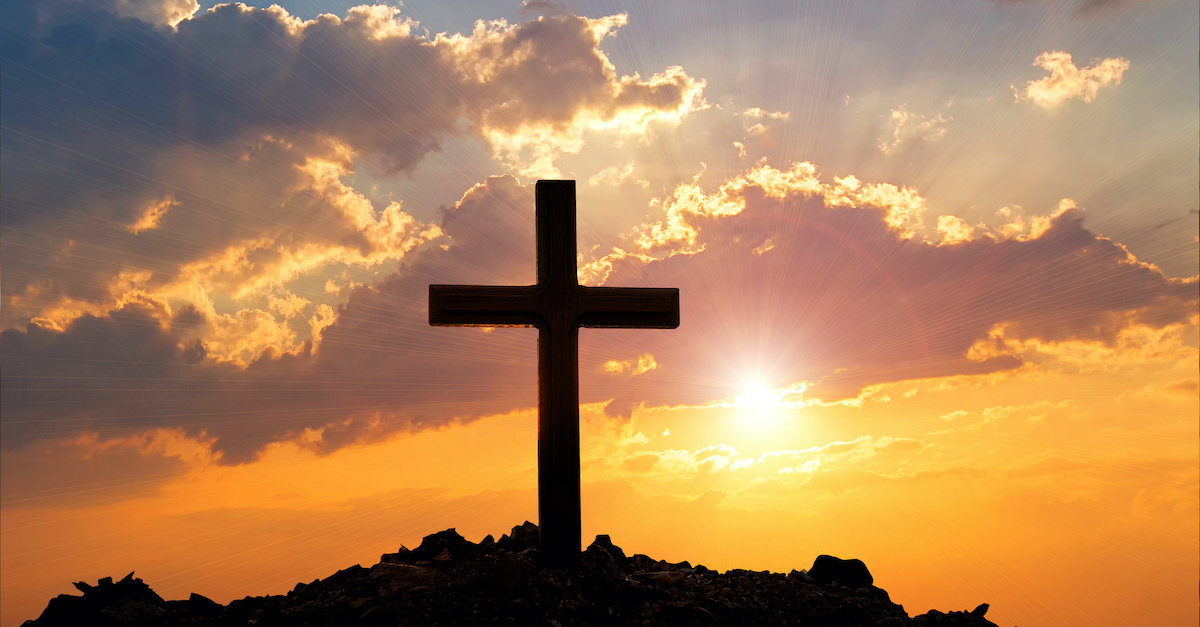What Exactly Is a Theophany?
Share

You have probably heard the word theology. You have also perhaps heard of the word epiphany. Knowing that “theo” usually has something to do with God and that an epiphany is when knowledge suddenly comes upon you, it would be a decent guess to assume that a theophany is when you have one of those light-bulb moments in regard to your relationship with God. That would be a good guess, but it also would not be entirely accurate.
A theophany is the combination of two Greek compounds. Theos (God, god) and phainein (to appear). A theophany, then, is an appearance of God to human beings. But your previous guess was not entirely off the wall. A theophany is typically for the purpose of revealing something about the character of God. When God appears, He does so for a purpose. The term itself does not appear in Scripture, but the concept appears throughout.
What Qualifies as a Theophany?
What exactly classifies a theophany? If you see a picture of Jesus in your cheese toast does this qualify as a theophany? What about God appearing to Moses in a burning bush, is that one? When an angel appears to someone, do we use another term or is this too a theophany? When Jesus walked upon the earth was this a 24-7 theophany?
To answer these questions, we need a slightly more technical definition of a theophany. The best definition, in my opinion, comes from Vern Poythress: “A theophany is an appearance of God, an intense manifestation of the presence of God that is accompanied by an extraordinary visual display.” The words of Adrian Ivakhiv are also important in explaining a theophany as “an unambiguous manifestation of God to man.”
These definitions help us with our cheese toast questions. If you question whether something is God, then it does not fall under the category of a theophany. In the Old Testament when God appeared to humans, it was obvious. Consider the burning bush of Exodus 3. Yes, the LORD had to reveal himself to Moses as “the God of your father, the God of Abraham, the God of Isaac…” But notice from the text that Moses immediately understood the import and “hid his face, for he was afraid to look at God” (Exodus 3:10).
The key is that God manifests His presence clearly, regardless of the way in which he manifests that presence.
Different Types of Theophany
As Hebrews 1:1 says, “In the past God spoke to our ancestors through the prophets at many times and in various ways…” God also communicated his presence to people through theophanies in many ways. In the scriptures, God appears to humanity in thunderstorms, in clouds, in smoke, in pillars of fire, in chariots, as a man, as a warrior, as an angel, and among others in court scenes. As you can see, there are many different types of theophany. Many categorize theophanies into three categories: non-human form, appearance as a man, appearance as an angel.
What about dreams and visions? Some theologians consider these as a kind of theophany. It is a clear communication of the presence of God to humanity. Yet, some believe a theophany requires perception of external senses (meaning you have to see it with your physical eyes). As the Baker Encyclopedia of the Bible states it, “The use of the term theophany is restricted here to manifestations of God in temporary forms perceptible to the external senses, and thereby excludes divine manifestations in dreams or visions…”
What about Jesus? Is the incarnation of Christ a theophany? If a theophany is God appearing to humanity to communicate His presence, is Jesus not the ultimate theophany? Yes and no. It is true that Jesus is a visible representation of God. He is Immanuel—God with us. Again, Poythress says it well:
“But we should note that the incarnation of Christ is different from the Old Testament instances of theophany. The Old Testament theophanies are preliminary. They foreshadow and prefigure the coming of Christ in the flesh. The coming of Christ is their fulfillment, their climax (Matt. 5:17). In addition, Christ’s incarnation is permanent, while the theophanies in the Old Testament were temporary. God saw to it that the Old Testament appearances of God had built into them an indication of their preliminary nature. The Old Testament looks forward to the New, not only by direct predictions but also by symbols that depict beforehand aspects of who Christ is and what he will do to accomplish redemption. Thus, the Old Testament theophanies have a forward-looking and symbolic dimension.”
Poythress is saying what Hebrews 1:2 says, “but in these last days he has spoken to us by his Son…” Jesus is the fulfillment of every theophany. This is why some have pointed to Jesus as the angel of the Lord in the Old Testament.
Where Do We See Theophanies in the Bible?
In Exodus 33:20 God says, “you cannot see my face, for no one may see me and live.” It is clear, then, that if God desires to appear to humanity it will need to be a mediated presence. This is why we see the theophanies we do through the Old Testament. Here are a few of the more vivid theophanies in the Bible.

Photo credit: Unsplash/Priscilla Du Preez
Abraham in Genesis 18
Here we read that “the LORD appeared to [Abraham] by the oaks of Mamre.” How did he appear? “He lifted up his eyes and looked, and behold, three men were standing in front of him.” It is here that God’s promise to Abraham to have a child is made again.
These men are invited into the home of Abraham and Sarah. From the language in this passage, it appears that one of these men is the Lord and the other two are angels. Some believe that this is a pre-incarnate appearance of Christ (this is what we call a Christophany). It is important, though, because God is making his presence known as one who fulfills His promises. God also appeared to Abraham in Genesis 12 and 22. When God appeared to Abraham it was usually related to His original covenant and promise to bless Abraham.
Jacob in Genesis 32
Jacob, the grandson of Abraham, is running away from his brother Esau. It is the night before his meeting with his estranged brother—will Jacob die tomorrow? Here we read that Jacob meets a man who “wrestled him until the breaking of the day.” This is one from whom he could not flee.
As the story unfolds, we see that this is no mere man. As Jacob would say, “For I have seen God face to face, and yet my life has been delivered.” This encounter fundamentally changed Jacob. Not only did it give him a limp, but it also gave him a new name; Israel. God’s presence to Jacob was both healing and bruising.
Moses in Exodus
We’ve already discussed the burning bush experience in Exodus 3, but God also appeared to Moses and the Israelites in Exodus 13:20-22. Here he appears to them in a pillar and a cloud. Here God’s presence leads them out of Egypt, through the wilderness, and ultimately into the Promised Land.
We see the importance of this in Exodus 33. When God says he will not go with them into the Promised Land, Moses essentially tells God that if He doesn’t go with them then there is no point in them being in the Promised Land.
There is another theophany in Exodus 19 as the Law comes through lightning and thunder, as well as in Exodus 24:9-11 when God appeared to Moses and the seventy elders. For Moses and the Israelites, these theophanies are a sign of God’s continuing presence with them as He rescues and redeems them out of Egypt and establishes them as His people. There is also an appearance of God in Deuteronomy 31:14-15 as the leadership passes from Moses to Joshua.
Theophanies in Joshua and Judges
There is some debate about the identity of the commander of the Lord’s Army in Joshua 5:13-15. It is likely a Christophany. Joshua certainly identified the man as the Lord because he fell to the earth and worshiped. This man, though, let Joshua know that He was in charge of the Lord’s army. He would be the one leading them into victory.
We see another appearance in the time of Manoah and his wife in Judges 13. The man in this story prophesied that the barren woman would have a child—and this child would be Samson. Here we see an explicit identification of the Angel of the Lord as God Himself. There is also a theophany with Balaam and the donkey in Numbers 22.

Photo credit: ©Getty Images/kckate16
Later Theophanies
It’s not surprising that there are more theophanies before the temple and the ark were built. Theophanies are all about the presence of God, and as Israel grew as a people the way God related to them was also a bit different. If you wanted to be in God’s presence during the time of the kings, then you’d go to where the ark of the Covenant was located. So it’s not surprising that there are few theophanies during this period. Yet, we do see in Israel’s later history, as she is exiled, another theophany in Daniel 3. Certainly the other man in the fire is none other than God Himself. Once again, God makes Himself known to His people. His presence means rescue.
Do We Only See Theophanies in the Old Testament? Do Theophanies Occur Today?
There are certainly appearances of God even in the New Testament. There are visions before the birth of Christ. And after the ascension we see God appear to the apostle Paul, to Peter, and to others. Many of these should technically be called a Christophany instead of a theophany. Jesus is the fulfillment of God’s presence. He is the one to which every theophany was pointing. He is the one who mediates to us the presence of God.
Whether theophanies occur today probably depends upon your definition. I would argue that the only thing which happens today is a Christophany. Though it could be argued that every theophany is technically a Christophany because God’s chosen instrument for mediating His presence is the Christ. Does God still make His presence known to humanity? Absolutely. Does he often do this through unconventional means? Definitely. Whether we can properly call these theophanies or not is something which theologians can debate. But the main point of a theophany is to know that God is present with humanity. That is ultimately expressed through Christ.
Though it is a term that does not appear in your Bible, a theophany is an important theological concept. It means that God desires to be present with humanity. This is incredibly good news. Every theophany you see in the Old Testament is ultimately pointing to the fulfillment in the Lord Jesus. Because of His accomplishment, we can rest assured that God can tabernacle (be present) among us. And it is through Jesus that we will finally and fully experience the presence of God with us (Revelation 21).
Sources
Elwell, W. A., & Beitzel, B. J. (1988). Theophany. In Baker encyclopedia of the Bible (Vol. 2, p. 2050). Grand Rapids, MI: Baker Book House.
Related articles
Does God Come to Earth before Jesus’ Birth?
5 Important Lessons from Jacob's Wrestling Match with God
How Is God the Same Yesterday, Today, and Forever?
Photo credit: Unsplash/Greg Rakozy